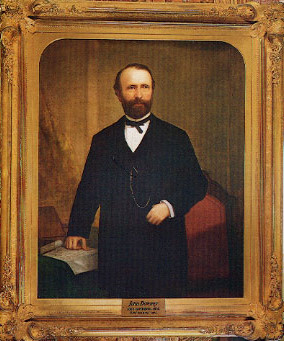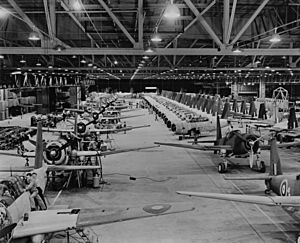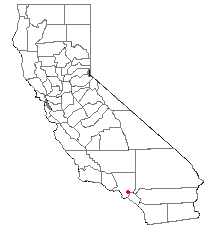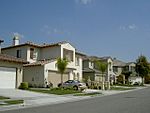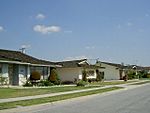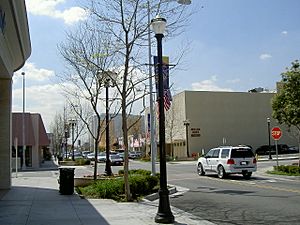Downey, California facts for kids
Quick facts for kids
Downey, California
|
|||
|---|---|---|---|
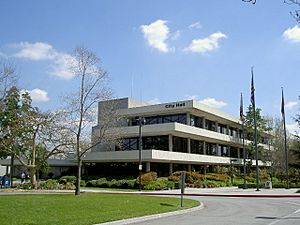
The Downey City Hall in 2006
|
|||
|
|||
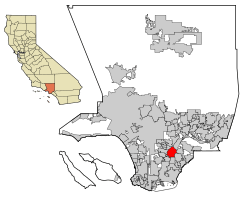
Location of Downey in Los Angeles County, California
|
|||
| Country | |||
| State | |||
| County | Los Angeles | ||
| Founded | October 23, 1873 | ||
| Incorporated | December 17, 1956 | ||
| Named for | Gov. John G. Downey | ||
| Government | |||
| • Type | Council–manager | ||
| Area | |||
| • Total | 12.57 sq mi (32.55 km2) | ||
| • Land | 12.41 sq mi (32.14 km2) | ||
| • Water | 0.16 sq mi (0.42 km2) 1.27% | ||
| Elevation | 118 ft (36 m) | ||
| Population
(2020)
|
|||
| • Total | 114,355 | ||
| • Rank | 10th in Los Angeles County 57th in California |
||
| • Density | 9,215.49/sq mi (3,558.25/km2) | ||
| Time zone | UTC−8 (PST) | ||
| • Summer (DST) | UTC−7 (PDT) | ||
| ZIP Codes |
90239–90242
|
||
| Area code | 562 | ||
| FIPS code | 06-19766 | ||
| GNIS feature IDs | 1652698, 2410352 | ||
Downey is a city in Los Angeles County, California. It is about 13 miles (21 km) southeast of Downtown Los Angeles. Downey is famous for being the birthplace of the Apollo space program and Taco Bell. It is also home to the oldest McDonald's restaurant still open today. In 2020, about 114,355 people lived in Downey.
Contents
History of Downey
Early Days: Before Spanish Rule
Long ago, before the Spanish arrived, the land where Downey is now was home to the Tongva people. They were also called the Gabrielino by the Spanish. Their villages were likely near what is now Downey. However, floods from the San Gabriel River made it hard to find their exact locations.
From Spanish Times to World War II
Mission San Gabriel Arcángel was first built in 1771 near the Tongva villages. Flooding later forced the mission to move to its current spot in San Gabriel.
In 1784, a large land grant was given to Manuel Nieto. This land, called Rancho Los Nietos, was huge! It stretched from the Santa Ana River to the Los Angeles River. After Nieto passed away, his land was divided among his children. The Downey area became part of Rancho Santa Gertrudes.
After the Mexican–American War in 1848, many large ranches were bought by wealthy Americans. They often married into the Spanish families who already lived there.
Dairy farming became a big business in Downey. Farmers also grew crops like grain, corn, and fruit. By 1935, Downey was known as an "orange-grove town."
Downey was founded by John G. Downey, who was born in Ireland. He was the youngest governor of California. He helped create the modern way of dividing land into smaller plots for homes.
After World War II: Aerospace and Growth
After World War II, many farms were replaced by homes and factories. Downey officially became a city in 1956.
One of Downey's biggest employers during the war was Vultee Aircraft. They made many military planes. Later, this company became part of North American Aviation. This company's facilities in Downey were very important for the Apollo Space Program and the Space Shuttle. For over 70 years, this plant made and tested many amazing aircraft and space vehicles.
By the 1990s, the plant closed down. This was a big change for Downey. The old plant site is now home to the Columbia Memorial Space Center. It also has a shopping center, a hospital, and city parks.
Other Important Places
In the 1960s, a busy intersection was at Lakewood Boulevard and Firestone Boulevard. These roads were important for travel between cities like Pasadena and Long Beach.
Downey was also known for its music scene. Downey Records released popular songs, and later, bands like The Blasters started here. The city is also home to Rancho Los Amigos National Rehabilitation Center. This hospital helps people with serious injuries.
Geography and Climate
Downey is located in Southern California. It covers about 12.6 square miles (32.6 km²). Most of this area is land, with a small amount of water.
Downey is surrounded by other cities. To the west are South Gate and Bell Gardens. Pico Rivera is to the northeast. Santa Fe Springs and Norwalk are to the east. Paramount and Bellflower are to the south.
Downey's Weather
Downey has a semi-arid climate. This means it usually has hot, dry summers and mild, wet winters.
People of Downey
Downey has grown a lot over the years. In 1960, about 82,505 people lived here. By 2020, the population had grown to 114,355 people.
The city is very diverse. Many different cultures and backgrounds make up the community. In 2020, a large part of the population was of Hispanic or Latino heritage.
Economy and Jobs
Business-Friendly City
In 2017, Downey was named the "Most Business-Friendly City" in Los Angeles County. This award was for cities with more than 68,000 people. It means Downey is a good place for businesses to grow.
Top Employers in Downey
Many people work in Downey. Here are some of the largest employers in the city:
| # | Employer | # of Employees |
|---|---|---|
| 1 | Kaiser Permanente | 5,400 |
| 2 | Stonewood Center | 2,000 |
| 3 | Rancho Los Amigos National Rehabilitation Center | 1,600 |
| 4 | PIH Health Hospital - Downey | 1,500 |
| 5 | Office of Education, County of Los Angeles | 1,425 |
| 6 | Downey Unified School District | 1,354 |
| 7 | Coca-Cola Refreshments | 800 |
| 8 | Internal Service Department, County of Los Angeles | 712 |
| 9 | City of Downey | 700 |
| 10 | Lakewood Health Center | 450 |
Culture and Fun Facts
The writer Tom Wolfe wrote about Downey in his book "The Pump House Gang." He talked about Harvey's Drive-in and the cool styles people wore there.
In 1955, Downey made news around the world because of a strange mystery. A man named George Di Peso tried to get rid of a gopher by putting a hose down its hole. But the hose started to disappear! Newspapers everywhere, even in Tokyo, reported on the vanishing hose. People wondered what was happening. It was probably an underground river pulling the hose away.
There was a rumor in the 1960s that the Downey City Library banned Tarzan books. People thought it was because Tarzan and Jane weren't married when they had a child. But this was just a rumor! No Tarzan books were ever banned.
Education in Downey
Schools for Kids and Teens
Most students in Downey go to schools in the Downey Unified School District. Downey has two main public high schools: Downey High and Warren High. These schools are named after important California governors.
Downey also has a third public high school, Columbus High School. There are several middle schools and elementary schools too.
- Stauffer Middle School
- Doty Middle School
- Griffiths Middle School
- Sussman Middle School
- Alameda Elementary School
- Carpenter Elementary School
- Gallatin Elementary School
- Gauldin Elementary School
- Imperial Elementary School
- Lewis Elementary School
- Old River Elementary School
- Price Elementary School
- Rio Hondo Elementary School
- Rio San Gabriel Elementary School
- Unsworth Elementary School
- Ward Elementary School
- Williams Elementary School
There are also private schools in Downey, including:
- Calvary Chapel Christian School (pre-K to 12th grade)
- St. Pius X-Matthias Academy (9th to 12th grade)
- Our Lady of Perpetual Help School (TK-K to 8th grade)
- Saint Raymond's Catholic School (pre-K to 8th grade)
- Saint Mark's Episcopal School (pre-K to 8th grade)
Downey City Library
The Downey City Library serves everyone in the city. The first library in Downey started in 1901. The current library building opened in 1959. It was expanded in 1984.
In 2019, the library began a big remodel. Even with delays from the COVID-19 pandemic, the new library opened in May 2021. It has cool new features like mobile app support for checking out books and a community space.
Getting Around Downey
Roads and Public Transport
Downey is easy to reach by several major freeways. The I-105 and the Metro C Line train pass through the south of the city. The I-5 runs through the northern part. The I-605 is on the east side, and the I-710 is just west of Downey.
The Los Angeles County Metropolitan Transportation Authority (Metro) provides bus services in the city. There is also a local bus service called DowneyLINK.
Famous People from Downey
Many well-known people have connections to Downey!
- Dave Alvin: Musician, started the band The Blasters.
- The Carpenters: Famous singer-musicians Karen and Richard Carpenter lived in Downey.
- Miranda Cosgrove: Actress and singer, known for iCarly.
- Art Cruz: Drummer for the band Lamb of God.
- Walt Faulkner: Race car driver, first rookie to win pole position at the Indianapolis 500.
- Ty France: Professional baseball player.
- James Hetfield: Lead singer and guitarist for the band Metallica.
- Allison Iraheta: Musician, from American Idol.
- Kerry King: Guitarist for the band Slayer.
- Evan Longoria: All-Star baseball player.
- Bob Meusel: Baseball star for the New York Yankees, played with Babe Ruth.
- "Weird Al" Yankovic: Musician and parody artist, was born in Downey.
Sister Cities
Downey has "sister cities" around the world. These are cities that partner together to promote cultural ties and understanding.
 Alajuela, Costa Rica
Alajuela, Costa Rica Efrat, Israel
Efrat, Israel Fresnillo, Mexico
Fresnillo, Mexico Guadalajara, Mexico
Guadalajara, Mexico San Quintín, Mexico
San Quintín, Mexico Taghmaconnell, Ireland
Taghmaconnell, Ireland
Local News
The Downey Patriot is a weekly newspaper that covers news for the Downey community. Larger newspapers like the Los Angeles Times and the Press-Telegram also provide daily news for the area.
Images for kids
See also
 In Spanish: Downey (California) para niños
In Spanish: Downey (California) para niños





